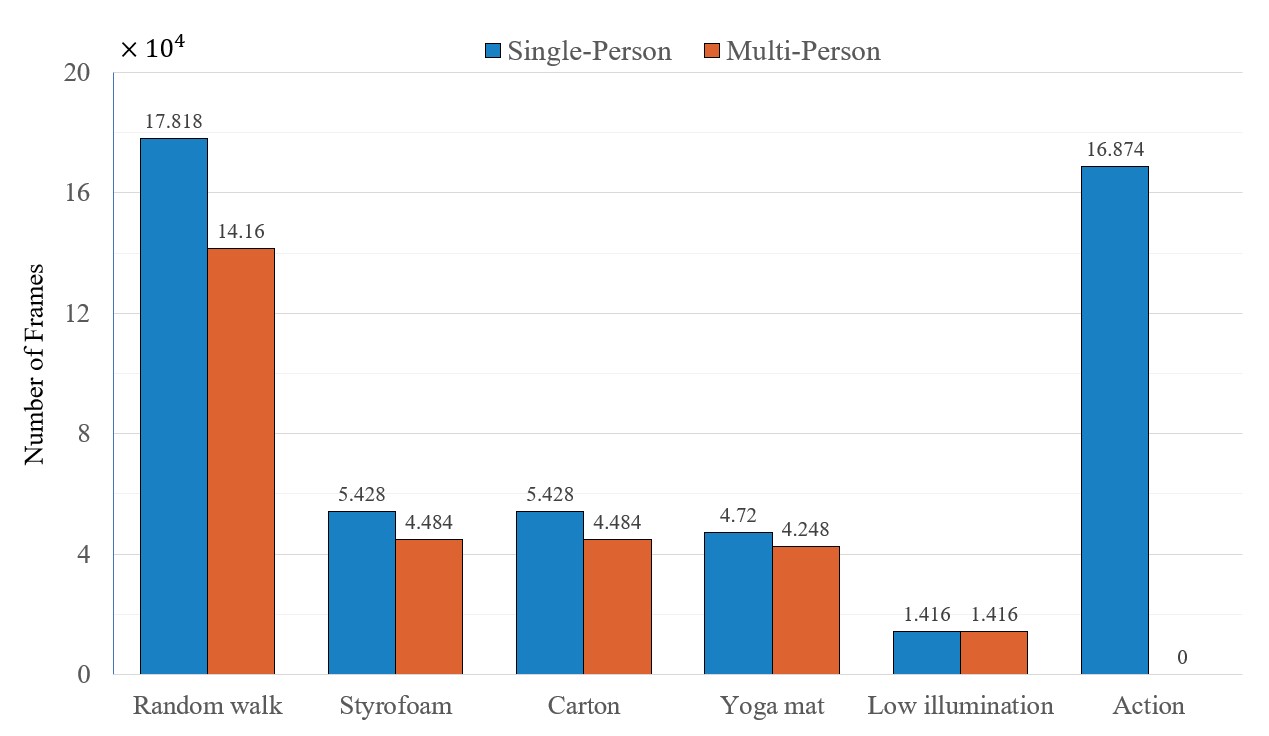HIBER(Human Indoor Behavior Exclusive RF dataset) is an open-source mmWave human behavior recognition dataset collected from multiple domains(i.e., various environments, users, occlusions, and actions). It can be used to study human position tracking, human behavior recognition, human pose estimation, and human silhouette generation tasks. The total size of the processed dataset is 400GB, including RF heatmaps, RGB images, 2D/3D human skeletons, bounding boxes, and human silhouette ground truth. Following, we introduce the composition and implementation details of this dataset.
- 10 environments:placing FMCW radars in ten different places of the same room.
- 10 volunteers:10 users of different ages, heights, and weights are involved.
- 4 actions: stand, walk, sit, squat.
- 3 occlusions:styrofoam occlusion, carton occlusion and yoga mat occlusion.
- 3 types of annotations: 2D/3D human pose indicating human actions, bounding boxes showing human positions and human silhouette results
- Our RF data is collected by two TI AWR2243 mmWave radars, each of which is composed of an MMWCAS-DSP-EVM (left two images) and an MMWCAS-RF-EVM (right two images).
- The parameters of the radars are set as follows:
| Parameter | Value | Parameter | Value |
|---|---|---|---|
| Start frequency | 77 GHz / 79 GHz | Sample points | 256 |
| Frequency slope | 38.5 MHz/µs | Sample rate | 8 Msps |
| Idle time | 5 µs | Chirps in one frame | 1 |
| Ramp end time | 40 µs | Frame Interval | 50 ms |
Under these settings the radar achieves a frame rate of 20 fps, and a range resolution of 0.122 m. We activate 12 transmitting antennas and 16 receiving antennas to obtain an approximately angular resolution of 1.3°.
- The optical camera images are collected by 13 Raspberry Pi 4B equipped with PoE (Power-over-Ethernet) module and Camera V2 module, as illustrated in the following figures.
- All 12 Cameras are calibrated using Zhang's Algorithm to calculate 3D human skeletons precisely. Specifically, we adopt kalibr in our implementation.
- The frame rate of Optical cameras is set to 10 fps, and the resolution of captured images is 1640 x 1248 (width x height).
- As illustrated in the following left figure, we fixed the positions of the first 12 cameras (indexed 0-11), and put the 13th camera (indexed as 12) alongside two radar devices to capture optical images and RF signals simultaneously.
- All devices ( including Raspberry Pi and FMCW radars ) are synchronized through NTP protocol, achieving millisecond error.
- The 13th camera alongside the radars is placed at ten different places to simulate different environments.
- As depicted in the following right figure, two FMCW radars are placed perpendicular to each other to collect RF signals from the horizontal and vertical planes, respectively.
We scatter the real-world space into horizontal and vertical grids (the distance of adjacent sampling points is 5cm). After applying beamforming pointwise, the original signal sampling points are processed into two 2D arrays (horizontal and vertical, as depicted in the following figures). The subtraction between adjacent frames is adopted to eliminate static object reflections in the environment and amplify the dynamic reflections.
We adopt AlphaPose to obtain 2D human skeletons in each camera and reproject 2D skeletons into real-world coordinates to calculate 3D human skeletons with the help of well-calibrated multi-camera systems.
- Each RF heatmap is saved as a Numpy array with the shape of (160, 200, 2), both horizontal and vertical heatmap. The first two dimensions represent the height and width of heatmaps, the last dimension is the real and imaginary parts of complex signals at corresponding positions.
- Each 2D/3D skeleton annotation is saved as a Numpy array with the shape of (N, 14, M), N denotes the number of persons in the current frame, 14 denotes 14 keypoints, M is equal to 2 or 3, representing (x, y) in image coordinate system or (X, Y, Z) in real-world coordinate system.
- Each bounding box annotation is saved as a Numpy array with the shape of (N, 4), N denotes the number of persons in the current frame, box is in the format of
xyxy. - Each silhouette results is saved as a Numpy array with the shape of (N, 1248, 1640), N is the number of persons in the current frame, 1248 is the height of the RGB frame, and 1640 is the width of the RGB frame.
The following figure shows the statistical result of our HIBER dataset. Our data contains different number of persons acting various actions in lots of scenarios.
See HIBERTools for detailed data format introduction and HIBERTools tutorial.
To obtain the dataset, please sign the agreement which should be stamped with the official seal of your institution, then scan and send it to wzwyyx@mail.ustc.edu.cn. Then you will receive a notification email that includes the download links of the dataset within seven days.
If you use this dataset, please cite the following papers RFMask and RFGAN:
@ARTICLE{9793363,
author={Wu, Zhi and Zhang, Dongheng and Xie, Chunyang and Yu, Cong and Chen, Jinbo and Hu, Yang and Chen, Yan},
journal={IEEE Transactions on Multimedia},
title={RFMask: A Simple Baseline for Human Silhouette Segmentation With Radio Signals},
year={2022},
volume={},
number={},
pages={1-12},
doi={10.1109/TMM.2022.3181455}}
@ARTICLE{9720242,
author={Yu, Cong and Wu, Zhi and Zhang, Dongheng and Lu, Zhi and Hu, Yang and Chen, Yan},
journal={IEEE Transactions on Multimedia},
title={RFGAN: RF-Based Human Synthesis},
year={2022},
volume={},
number={},
pages={1-1},
doi={10.1109/TMM.2022.3153136}}
You may also be interested in the gesture recognition dataset and the following paper DIGesture:
@misc{DIGesture,
title={Towards Domain-Independent and Real-Time Gesture Recognition Using mmWave Signal},
author={Yadong Li and Dongheng Zhang and Jinbo Chen and Jinwei Wan and Dong Zhang and Yang Hu and Qibin Sun and Yan Chen},
year={2021},
eprint={2111.06195},
archivePrefix={arXiv},
primaryClass={cs.CV}
}





